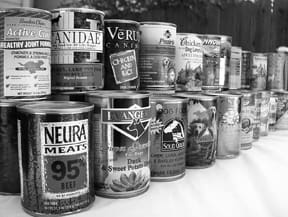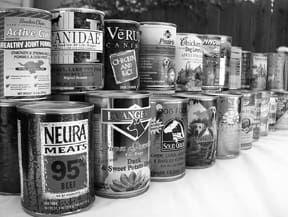Dog food is a big deal, here at WDJ. This is partly because its so important (all dogs eat food), and partly because its so complex. Regulation of the pet food industry in this country is spotty at best. Enforcement of what rules there are is practically non-existent. And nutritionists still argue among themselves about what dogs need.
Educating ourselves about what our dogs are eating is important. Its also difficult. The pet food industry is not accustomed to scrutiny; many manufacturers feel it is simply not in their best interests to reveal everything about their foods. And because the best foods are usually made by small companies with smaller advertising budgets, it can be hard to locate their products.

Well be revisiting the dog food issue frequently, due to its scope, complexity, and relevance. We reviewed dry dog foods in the April 1998 issue, including a glossary of dog food ingredients, and information about the Association of American Feed Control Officials (AAFCO), the only organization that approves or disapproves of commercial dog foods. This month, were reviewing canned dog foods, and telling you about what kind of foods go into dog foods…
No one should ever have to see the making of sausage or laws, someone once said. Perhaps we ought to add the making of dog food to that list. The more you know about this industry, the more you want to make an appointment with your friendly neighborhood grocery store butcher, to discuss the best and most affordable cuts of meats for dogs. Because meat, as anyone who knows anything about optimum nutrition for dogs will tell you, is the food that all diets for dogs should be constructed around. (Dont get excited if your dog is allergic to meat; he is the exception, not the rule.)
But it is inconvenient and expensive to buy, store, and prepare meat. And because dogs are considered omnivores (they eat meat and plant materials), not true carnivores (animals that eat only meat), you need to supplement their diets with bits of this and that to satisfy their nutritional needs.
And, if theres anything humans hate, its inconvenience and expense, so an entire multi-billion-dollar industry has sprung up to make feeding our dogs easier. Thanks to the dog food companies, we can take care of our dogs needs by just ripping open a paper bag, or getting out the old can opener and spooning a bunch of glop into a bowl. Voila! Fido is fed. And we paid less for that glop, in most cases, that we would have for fresh meat. So whats the problem?
The problem is, our dogs are suffering from a vast multitude of allergies and illnesses and unsoundnesses. They develop cancers of every conceivable description. They have trouble reproducing, and they die young. They itch all over, their eyes drip, their ears exude wax, they smell awful, and they have diarrhea half the time and constipation the other half.
Could this have anything to do with the food they eat every day?
Well, lets look at their food. Whats in this stuff, anyway?
Second-class food
It shouldnt be a surprise to anyone that dogs eat the stuff that we wont parts of animal carcasses that we think are unappetizing, like bones, brains, blood, intestines, ligaments, etc. After all, wild dogs eat absolutely every part of the animals they eat the parts that offer lots of quality nutrients, as well as the parts with lesser amounts of nutrients. But many people are unaware that unless a dog food says it contains meat, it contains only the parts of animal carcasses that are of minimal use to the dog. Highly processed meat by-products, animal fat, meat and bone meal, offer almost no nutrition to the dogs that eat them. Thats why we would never recommend any dog food that contains any meat by-products.
But even products that utilize the best parts of animal carcasses the more nutritious, choice cuts of muscle tissue and fat from chicken and other poultry, beef, lamb, and fish are second rate, compared to what humans eat. The pet food industry interprets the term unfit for human consumption as wonderfully fit for canine consumption. This includes meat from animals that arrived at the slaughterhouse in a condition that the inspectors lightly call 4-D: dead, dying, diseased, and disabled. It includes meat that was too high in hormones, pesticides, or other medications to qualify for human consumption.
Not just meat discards are fed to our dogs. We also give them the discards from our grain and vegetable industries! Corn starch, wheat gluten, beet pulp, tomato pomace these are the parts of the plants that arent used in human foods. Its little wonder that most of the gigantic processed human food companies own pet-food subsidiaries: no waste!
Then, to make up for the low-quality foods and for the loss of almost all the foods nutrients due to processing, the manufacturers add vitamins and minerals. Without this supplementation, the food would be useless to its consumers.
Looking for quality sources
Nutrition experts know the secret to health is healthy food. Dog food pioneers, including holistic veterinarians and breeders, have long known this is true for dogs, too. If your dogs health is THE most important factor in choosing his food, then you will feed him a diet based on fresh, raw meat.
But if you cant or wont make your dogs food yourself, and yet want your dog to eat the best food you can buy, the task is finding products with the best-quality ingredients. This means whole foods, not just cast-off parts of foods. It also means meats that are human-grade. Obviously, this means the food is going to be more expensive than food made of what is essentially garbage.
Canned food considerations
Canned foods have a few inherent advantages and disadvantages. A dog who eats nothing but canned food, even if it is of the very best quality available, will require access to additional foods, treats, and/or toys that offer enough abrasive action to clean their teeth and exercise their gums. Canned food is also expensive. For these reasons, few experts, if any, recommend feeding nothing but canned food. Most suggest that canned food be offered to dogs as a top dressing on kibble.
On the plus side, despite the common perception that canned foods are chemical soups, they actually contain way fewer chemical additives than dry foods. Artificial colors and flavors are uncommon in the better foods, and much less common in the worst foods than they are in their dried food equivalents. Preservatives are unnecessary and rarely seen, due to the sealed, oxygen-free environment that a can offers. (Because of the lack of preservatives, canned foods MUST be kept refrigerated after opening, just like any other meat. And if a dog doesnt finish all of his canned food immediately, the food must be discarded. Harmful bacteria can quickly develop in meat-based foods that linger at room temperature.)
The most common chemical additives in canned food are stabilizers, emulsifiers, and thickening agents. These include carrageenan gum, guar gum, vegetable gum, potassium chloride, dicalcium phosphate, and calcium carbonate.
Most other ominous-sounding chemicals are vitamin and mineral sources. Some of the most commonly seen include: choline chloride, a dietary supplement in the B complex; ferrous sulfate, a nutritional iron source; manganese oxide, a nutritional manganese source; and calcium pantothenate, a B-complex vitamin.
AAFCO approval
One of the recommendations we made when we compared dry dog foods (April 1998 WDJ) was that an owner pay attention to any prospective foods label regarding something called AAFCO.
A two-tiered approval is available from the Association of American Feed Control Officials. The first level is a minimum requirement: It must be formulated to meet the nutritional levels established by AAFCO.
The second level is optional. For a fee, reputed to be significant, a manufacturer can submit his food to an AAFCO-designed feeding trial. The test is not rigorous; the feeding trial needs to last only six months and utilize a minimum of eight dogs. At least six of the dogs must finish the trial (not be removed due to illness or death). If the food passes, the maker may state on the food label that feeding trials substantiated that the food was able to provide complete and balanced nutrition for maintenance of dogs.
Interestingly, only one of the 30 or so dry dog foods we looked at in April used the meets the nutritional levels statement. All of the rest had the feeding trials label. We found this significant, and disqualified that one food from our consideration. We explained that since the feeding trial is not all that difficult, the fact that a company would pass on taking that test must signify that the product is inferior that, perhaps, it couldnt even pass that wimpy test!
But only about half of the canned foods we found good and bad foods boast the feeding trials claim. And only about a third of our favorites use the feeding trials wording.
One of the smaller (and high-quality) food makers explained it to us this way: The tests cost a lot of money, and they duplicate studies that the company has already conducted. The feeding trials statement is just not important enough for our commercial success to pursue it.
This information about AAFCO approvals is just inconsistent enough to make us put an article about the organization on our Future Projects list. For now, considering the obvious quality of some of the foods being marketed without the AAFCO feeding trials statement, were going to disregard the AAFCO status of each food. For now.
WDJ selection criteria
We required the following for a product to make it into the running for our Top 10 Canned Dog Foods:
No artificial colors, flavors, or preservatives
No meat and bone meal
No meat by-products (This requirement is what was responsible for eliminating popular brands such as Iams, Waltham, Science Diet, Excel, and Abacus.)
A quality, whole meat in the top two ingredients (in cannedfoods, water is usually the first or second ingredient)
All whole foods, not a hodgepodge of reconstituted parts, i.e.rice, rather than rice flour, rice bran, brewers rice, etc. (Thisis what eliminated Nutro and NutroMax brands)
Price is a consideration, but not one that WDJ should decide for you. Weve converted the prices of each product in the chart below, so that you can compare apples to apples. Youll have to choose for yourself how much you want to spend on your dogs moist meals.
Our top 10 canned foods follow. They are not ranked, but are listed from least expensive to most expensive; when their prices are the same, they are listed alphabetically.
WDJs TOP 10 CANNED DOG FOODS
Breeders Choice Avo-Derm
The use of lamb broth instead of water is a nutritional plus. The maker is particularly forthcoming about the sources of his ingredients, always a good sign of quality. (800) 255-4286.
Solid Gold
How did they manage to make a canned food without added water for processing? We dont know, but what this means to us is that were paying for food. And its good food! (800) DOG-HUND.
Hi-Tor Eno-Diet
With water in the first position on the label, you should expect the reduced protein level. But the ingredients are better than average. (800) 331-5144.
California Natural
A simple, short ingredients list, plus the makers guarantee that only human-grade foods are used. Hard to beat. (800) 532-7261
Canidae
A relative newcomer, Canidae can be hard to find, but is worth the effort, with several quality protein sources and chicken broth replacing water.(800) 398-1600.
Innova
An attractive-looking food, with identifiable contents. Nice ingredients list for the dog who likes veggies with his meat.(800) 532-7261.
Wysong Maintenance
The only food we examined that didnt smell like dog food! In fact, it looks and smells yummy. The maker is devoted to quality ingredients. (517) 631-0009.
Neura 95 (95% beef)
One of the six varieties sold under this label, the 95% Beef is guaranteed to be 95% beef. Watch out for WDJs not recommended ingredients in the other five. (800) 225-0904.
Petguard (with coleman beef)
The only dog food weve ever seen with certified organic beef. This top-notch food is appropriately placed at the top of the ingredients list. (800) 874-3221.
Spots Stew
This is wildly expensive food that we wouldnt mind eating for dinner seriously. The maker guarantees all ingredients are human-grade. If you want only the best, and price is no object, this is it. A new, hard-to-find product. (800) 426-4256.
-By Nancy Kerns






